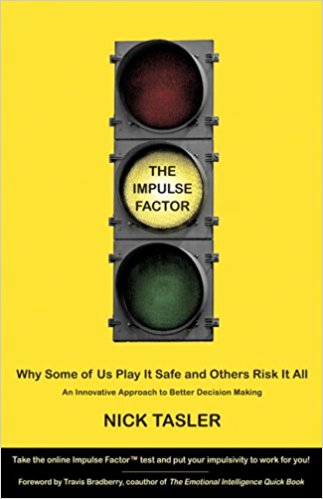The Impulse Factor Summary
4 min read ⌚
 Why Some of Us Play It Safe and Others Risk It All
Why Some of Us Play It Safe and Others Risk It All
The risk factor is hard to measure. It is almost impossible to determine what is risk-taker and how to define a risk avoider.
Do you prefer a more cautious approach?
Having a broader perception and insights on luck-tendencies can help you evaluate risk and its influence.
Who Should Read “The Impulse Factor”? And Why?
Nick Tasler, the author of “The Impulse Factor”, examines series of factors that can shape a person’s mindset including genetic predispositions. He declares that the societal approach has only two perspectives: “safe outcome” and “risk-taking”.
Both of them produce a variety of strengths and weaknesses; it is up to you to discover the perfect balance and adopt the one that suits you. We enter the decision-making process by prescribing this book summary to anyone willing to learn more about “impulsiveness” and other crucial managerial abilities.
About Nick Tasler
 Nick Tasler momentarily enjoys the privilege of working at Decision Pulse – consulting firm as a CEO. Throughout his career, Nick has worked with over 500 companies: conducting analysis, designing long-term plans, etc.
Nick Tasler momentarily enjoys the privilege of working at Decision Pulse – consulting firm as a CEO. Throughout his career, Nick has worked with over 500 companies: conducting analysis, designing long-term plans, etc.
“The Impulse Factor Summary”
A point often overlooked is the experiment conducted in order to catch on with “impulsiveness”. Many perspectives highlight the importance of the research supervised that day as an illustration of processing risk-aversiveness.
The researcher took a step forward by creating a quiz with two tempting offers: The first one was an all-inclusive offer in 5* hotels located in several European countries for three weeks.
The host displayed this gift for the price of a coin toss. On the other hand, you have a guaranteed first-class privilege transformed into a 7-days holiday in Italy. The one you choose reflects your “risky nature” or “cautiousness”.
Two offers are presented before you, make up your mind – Nick Tasler advises you to strap on a pair! Almost 80% of the people would go with option number two. You wonder why?
The author indicates a clear point here, is better something than nothing. The risk is too great for me to lose the entire “cake” – is that how you interpret? Adopting a sheltered attitude has its pros and cons, but remember not taking a risk is also a risk.
Gambling with luck represents the ultimate option number one, which means that you belong to the 20% risk-taking club. Increase your fortune by testing your chance of winning – a quote well-embraced.
Huge wins require a daredevil profile; a person with the eagerness to act rather than wait. There is no shortage of similar experiments and analyzes that produced the same outcome as the previous one. Scientists are examining the nature of alertness as an attribute imposed upon the middle-class.
Plenty of theories have been enforced. For instance, women are more aversive to risk than men, or older people are not so much prone to guessing. The cautious/impulsive ratio was measured in the 70s and remains unchanged to this day.
An average group or team of four persons has minimum one risk-lover inclined to show signs of impulsive behavior.
External influence can struck individuals in a negative way; backing down has become a habit as soon as we don’t earn respect. Also, a person needs to evaluate external and internal impacts which can sabotage any business. The inner category is composed of perception, perspective, knowledge, and intelligence.
All of them are reflecting your impulsiveness in given situations. Profit mania is a global phenomenon, a shadow of capitalism. Risk-takers or “trophy hunters” tend to get greedy, not to mention hungry – for success. As an illustration of this force, many people have conducted interviews, experiments, analysis all pointing out to the nature of taking a risk.
To demonstrate impulsiveness, risk managers are inclined to act tough and decisive in interactions with other people.
Few scientists have even come up with a behavioral code – “conditional impulsivity”. On the positive side, this concept enables people to harmlessly take a risk while maintaining a perfect ratio between gamble/gain.
Side by side a method named – “Functional impulsiveness” directs people to look forward when finding themselves in risky surroundings but with caution. “Dysfunctional impulsivity” is a term used to describe the wild nature, the worst of the worst.
With attention to unlikeness, a question emerges. Are you prone to risk for a potentially gold start or safe-betting is in your blood? Reminiscing is a useful tool that will help you to interpret your behavior because a straightforward answer is 99% of the time – wrong.
Key Lessons from “The Impulse Factor”
1. Stats versus good sense
2. Play safe and assess the gain
3. The best of both worlds
Stats versus good sense
In truth, impulsive people and risk avoiders are different when making decisions.
It’s essential to realize that these two contrasting characters interpret benefits uniquely. By all means, risk takers are gaining momentum by heavily relying on big rewards and victories.
Nevertheless, the stats are at least temporary inclined towards the other half.
Play safe and assess the gain
Most people are safe-players with cautious mindset. Under those circumstances, they tend to put extra attention on cons rather than pros.
For the most part, they look for every danger that may be lurking. Even politicians use this theory in their campaign strategies.
The best of both worlds
In brief, neither of the two mindsets can guarantee you an absolute win. It is up to you to evaluate and maximize your benefits.
Are you a team player or a loner? One thing is for sure – nothing is certain!
Like this summary? We’d Like to invite you to download our free 12 min app, for more amazing summaries and audiobooks.
“The Impulse Factor” Quotes
The organization that combines creativity and innovation has a significant competitive advantage. Share on X Because a presentation is usually informal, it can benefit from a creative, nontraditional approach. Share on X People, systems, and organizations are as they are because they are as they are. Share on X The rules are often understated and pervade the culture. Share on X The innovative organization has people who are not satisfied with doing their jobs the same old way. Share on XOur Critical Review
Are you a “potential seeker” or “risk manager” doesn’t change much if you have the potential to come out a winner, regardless of the circumstances.
We suggest a teaming up plan – togetherness of risk seekers and managers to reduce the errors. Anyone interested in big gains or avoiding losses will find this book amusing and thrilling.
Emir is the Head of Marketing at 12min. In his spare time, he loves to meditate and play soccer.


 Why Some of Us Play It Safe and Others Risk It All
Why Some of Us Play It Safe and Others Risk It All




